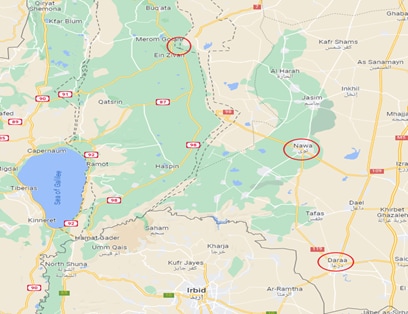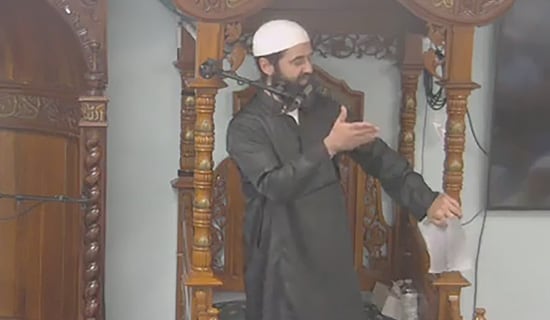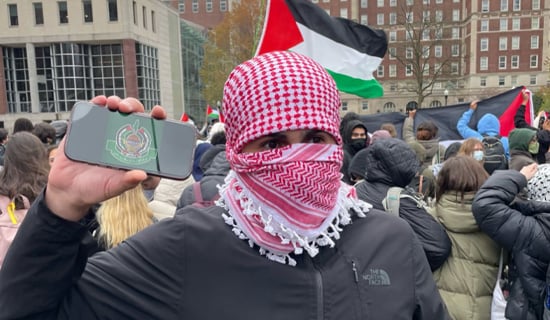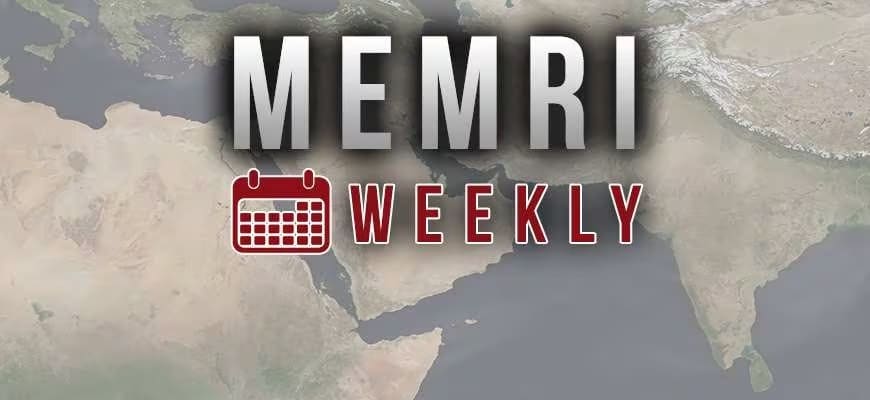Since Hamas attacked southern Israel on October 7, 2023, signs that Iran seeks to open another front against Israel from Syria are emerging. Along with reports of three incidents of rocket fire into Israel from areas of Syria under Syrian regime control, where Hizbullah and other Iran-backed militias are known to have a significant presence,[1]there are also indications of a possible widescale operation against Israel from Syria by the Iran-backed militias under the command of Iran's Islamic Revolutionary Guard Corps (IRGC).
These indications include reports of the reinforcement of forces in areas bordering Israel, with an emphasis on Quneitra and the Daraa region; the Syrian army's heightened alert level; threats by the Shi'ite militias to open a Golan front; reports of frequent and secret visits to Syria by IRGC Qods Force commander Esmail Qa'ani; and also visits by senior leaders of Iran-backed Shi'ite militias in Iraq to areas bordering Israel and the establishment of a joint operations room comprising Iran, Hizbullah, Iran-backed militias, and the Palestinian factions.
The extent to which the Syrian regime is a partner to Iran's desire to open a new front on Syrian soil is not clear. According to several Arab media reports, Syrian President Bashar Al-Assad has told Iran, the UAE, Egypt, and Hizbullah, that he does not want this because of his country's unstable situation due to the civil war, now in its 13th year.[2]At the same time, it is reasonable to assume that the regime will not be able to withstand the dictates of the ally who has significantly contributed to its survival. Likewise, the possibility that this is an attempt by the regime to prevent a preemptive attack by Israel cannot be ruled out.
The following are details about the indications that a new front in the current war may be opened against Israel from Syria:
Militias On Elevated Alert, Hundreds Of Fighters Throng To Southern Syria, Mobilization Of Operatives
Shortly after the war broke out on October 7, 2023, there were reports that Iran had ordered its men in Syria to raise the alert level and to redeploy in the Syria-Israel border area.[3] For example, it was reported that hundreds of fighters from the Iran-backed militias in the Deir Al-Zour, Homs, and Aleppo regions had been transferred as reinforcements for the forces stationed in southern Syria,[4] primarily in the Quneitra region on the border with Israel, in northern Daraa, and adjacent to the city of Nawa situated between Quneitra and Daraa. It was also reported that thousands more operatives had arrived at the border with Israel from Iraq, but no details were given as to whether it was Israel's border with Lebanon or with Syria.[5]
According to these reports, some of the forces are from Hizbullah's elite Radwan Force, and from Iran-backed Shi'ite Iraqi and Afghan militias. These forces are equipped with drones and advanced weaponry.[6] It should be noted that according to Arabicpost.net, this reinforcement has Russia's approval, and is a violation of the 2018 Russia-Israel-Jordan understandings that Russia will not permit the presence of militias in the border region.[7]
Northern Daraa: According to reports, reinforcements arrived in the region of Al-Sahealiyah village (Radwan Forces), Tal Al-Za'atar (Imam Hussein Brigade), Al-Sheikh Maskin (Hizbullah), and Tal Al-Qaad. The operatives, armed with Ababil drones, antitank missiles, and heavy artillery, began to strengthen the fortifications, and near Al-Sheikh Maskin a drone landing pad was also built.[8]
Nawa City: There is a concentration of militias in the Tal Al-Jabiyya and Tal Al-Jumu'a area, west of Nawa, about 10 kilometers from the border where the Syrian army's 61st> Brigade is deployed. Tal-Al-Jabiyya is fortified and equipped with electronic warfare equipment, suicide drones, and intelligence-gathering drones, as well as rockets mounted on vehicles, and advanced missiles. Two squads, one from each of these locations, fired rockets at Israel, on October 10 and October 14.[9]
Quneitra: Opposition websites reported that hundreds of operatives have been transferred to this area.[10] According to one report, there are concentrations of militias in the area of Tal Al-Sha'er and Tal Krum. The militias are armed with drones, missiles, and advanced weaponry.[11] Additionally, there are forces at a Syrian army base near Al-Bakkar village, and there are drones there as well.

Map showing the locations of Daraa, Nawa, and Quneitra
Recruiting New Operatives For The Militias
In addition to sending relatively veteran forces, it was reported that the Iran-backed militias stationed in Syria had begun recruiting new operatives from among the local population, particularly the Shi'ite population. The London-based Al-Sharq Al-Awsat daily reported on October 9, that the militias had begun fundraising and mobilizing volunteers in advance of a war on the Syria-Israel border.[12] Several days later, the Syrian Observatory for Human Rights reported that the militias had opened recruitment offices in the Deir Al-Zour area, with the aim of recruiting 1,000 new members. According to this report, the age range of potential recruits was 14 to 30. The recruits underwent about a month of military training as well as courses in Shi'ite religious law.[13]
Elevated Alert And Suspension Of Leave In Syrian Regime Army And Forces
Since the war began, there have been reports that the Syrian army has elevated the alert level for its forces and ordered all leave suspended. As early as October 10, the day of the Hamas attack, an opposition website reported that the Syrian Defense Ministry and general staff were suspending leave for all military personnel until further notice. At the same time, the army elevated its alert level across the country, particularly around Damascus and in southern Syria.[14] There were similar reports concerning officers and noncommissioned officers at military airports and facilities,[15] and in the security and intelligence apparatuses.[16] Even if the Syrian regime is not interested in entering the fray itself, as noted above, the fact that it made this decision, if indeed it has, indicates that it realizes that there is a reasonable likelihood that the war will expand to its soil.
Iraqi Shi'ite Militias Declare Their Readiness To Open A Front In The Golan
Since the outbreak of the war, senior officials in the Shi'ite militias have warned that they will respond decisively if Israel undertakes ground action in Gaza. In a phone conversation with Hamas political bureau chief Ismail Haniyeh, Al-Nujaba Secretary-General Akram Al-Ka'abi said that his organization supports the Palestinian resistance with "our weapons, our equipment, and our men" and that it is willing to provide any aid necessary.[17]
SUPPORT OUR WORK

In addition, the Al-Nujaba and IRGC Telegram channels published videos hinting at the activation of the Brigade to Liberate the Golan, which was established in 2017.[18]
Iran and its allies are not settling for mere declarations; according to various reports, they have begun to make moves on the ground in order to achieve these goals.
A Series Of Visits To Syria And Lebanon By IRGC Qods Force Commander Esmail Qaani And By Iraqi Shi’ite Militia Leaders
Unsurprisingly, the individual responsible for managing this front is IRGC Qods Force Commander Esmail Qaani. According to a report on Arabic.post, Qaani visited Syria on October 9, two days after the Hamas invasion of southern Israel, and again on October 15, in order to pressure Syrian President Bashar Al-Assad to permit operations to be carried out from Syrian territory. According to the report, Iran prefers to open the Syrian front rather than the Lebanese front in order to protect Hizbullah and its forces. It also said that the plan is ready and that it "will begin from the Golan with a ground operation that will be initially limited in scope."[19]
In addition, officials from Iraqi militias visited Syria and Lebanon in order to prepare the ground operationally. The Saudi Al-Sharq Al-Awsat daily reported on October 14 that delegations of Iraqi Shi'ite militias visited militia positions in Syria and Lebanon.[20]
The Establishment Of A Joint Operations Room For Coordination Between Iran, Hizbullah, Iran-Backed Militias, And Hamas; Gathering Of Intelligence Ahead Of An Attack
According to several reports, Iran has established and is running a joint operations room shared by it, Hizbullah, Iran-backed Shi'ite militias, and the Palestinian factions, with the goal of gathering intelligence and coordinating attacks against Israel and U.S. forces in the region.[21] Sayyed Al-Shuhada Brigades leader Abu Alaa Al-Wala'i has confirmed that such an operations room exists "within and outside of Iraq."[22]
Several sources have reported that as part of the preparations for the opening of the Syrian front, Iran and its militias have been gathering intelligence about targets inside Israel. Al-Sharq Al-Awsat has reported that one of the goals of the militia officials' visits to Syria and Lebanon was to gather intelligence, "to learn more about the details in the field," and to coordinate with local militias "ahead of any possible operation."[23]
In addition, it was reported that militias deployed in southern Syria along the border with Israel have been operating drones for intelligence-gathering purposes.[24]
[1] According to the Syrian opposition-affiliated Syriahr.com, factions that "work with Hizbullah" fired rockets at Israel on October 10 and 14. On October 29, three rockets were fired at Israel from a "Syrian military position" (Source: Facebook.com/damascusv001, October 30, 2023.)
[2] The Syrian regime has told Iran, Russia, the UAE, Egypt, and Hizbullah that it does not want to participate in the war due to the instability that has racked the country for more than 12 years of civil war. Sources: Al-Quds Al-Arabi (London), October 28, 2023; Arabicpost.net, October 18, 2023.
[3] Al-Sharq Al-Awsat (London), October 9, 2023.
[4] Syriahr.com, October 17, 2023.
[5] On October 18, 2023, the leader of the Iran-backed Iraqi Faylaq Al-Wa'd Al-Sadeq militia, Muhammad Al-Tamimi, announced that 5,000 fighters from his group and from other militias including the Iraqi Al-Nujaba Movement, the Sayyid Al-Shuhada Brigades, and the Imam Ali Brigades have been deployed on the border with Israel. He also said that 10,000 additional fighters are "waiting to join their brothers." Al-Tamimi did not specify whether the border in question was the Lebanese or Syrian border with Israel. See MEMRI JTTM report Iran-Backed Militia Leader In Iraq Says Five Thousand Iraqi Fighters Are On Israeli Border Awaiting 'Zero Hour' To Invade Israel, October 19, 2023.
[6] Euphratespost.net, October 17, 2023; Syriahr.com, October 18, 2023; Syria.tv, October 19, 2023. See also MEMRI JTTM reports: Arab And Syrian Opposition-Affiliated Media Outlets: Hizbullah, Iranian Islamic Revolutionary Guard Corps (IRGC), Additional Iran-Backed Militias In Syria, All Bolstering Forces In Southern Syria In Event That Fighting Between Israel And Palestinian Factions Spreads To Syrian Arena, October 10, 2023; Syrian Opposition Website: Elite Forces From Iran-Backed Militias Deploy Along Syrian Border With Israel On Golan Heights Under Hizbullah Supervision, With No Coordination With Syrian Regime, October 23, 2023; Syrian Opposition Websites: Iran-Backed Militias Enhance, Entrench Presence Along Syria's Borders With Iraq, Israel, October 26, 2023.
[7] Arabpost.net, October 18, 2023.
[8] Syria.tv, October 12, 2023; Arabi21.com, October 13, 2023. See also MEMRI JTTM Report: Arab And Syrian Opposition-Affiliated Media Outlets: Hizbullah, Iranian Islamic Revolutionary Guard Corps (IRGC), Additional Iran-Backed Militias In Syria, All Bolstering Forces In Southern Syria In Event That Fighting Between Israel And Palestinian Factions Spreads To Syrian Arena, October 10, 2023.
[9] See MEMRI JTTM Report: Syrian Opposition Websites: Iran-Backed Militias Enhance, Entrench Presence Along Syria's Borders With Iraq, Israel, October 26, 2023.
[10] Euphratespost.net, October 17, 2023; Syriahr.com, October 17, 2023. See also MEMRI JTTM Report Arab And Syrian Opposition-Affiliated Media Outlets: Hizbullah, Iranian Islamic Revolutionary Guard Corps (IRGC), Additional Iran-Backed Militias In Syria, All Bolstering Forces In Southern Syria In Event That Fighting Between Israel And Palestinian Factions Spreads To Syrian Arena October 10, 2023.
[11] Arabi21.com, October 13, 2023.
[12] Al-Sharq Al-Awsat (London), October 9, 2023.
[13] See MEMRI JTTM Report Arab And Syrian Opposition-Affiliated Media Outlets: Islamic Revolutionary Guard Corps (IRGC) And Iran-Backed Militias In Eastern Syria Recruiting Operatives To Send To Lebanon And 'Palestine' To Join Fighting Against Israel, October 12, 2023.
[14] Damascusv.com, October 7, 2023.
[15] Al-Sharq Al-Awsat (London), October 9, 2023.
[16] See MEMRI JTTM Report Syrian Opposition Website: Assad Regime Bans Vacations For Security, Intelligence Officers, Military Personnel As Part Of Increased Alert Due To Israel-Hamas War, October 18, 2023.
[17] Telegram.me/NOON_media, October 16, 2023.
[18] Telegram.me/Al_Nojaba, Telegram.me/iran_military_capabilities, October 19, 2023. For more information about the establishment of the Brigade to Liberate the Golan, see MEMRI Report, Spokesman For Iran-Backed Iraqi Shi'ite Militia In Syria: 'We Have Established The Golan Liberation Army', April 5, 2017.
[19] Arabicpost.net, October 18, 2023.
[20] See MEMRI Special Dispatch No. 10874, Saudi Daily: Shi'ite Militia Commanders Have Arrived In Lebanon And Syria Ahead Of Possible Involvement In Conflict With Israel, October 16, 2023.
[21] Al-Sharq Al-Awsat (London), October 16, 2023; Arabicpost.net, October 18, 2023.
[22] See MEMRI JTTM report Iran-backed Iraqi Kata'ib Sayyid Al-Shuhada' Milita: The U.S. Forces In The Region Will Be Legitimate Targets If America Intervenes, October 11, 2023.
[23]See MEMRI Special Dispatch No. 10874, Saudi Daily: Shi'ite Militia Commanders Have Arrived In Lebanon And Syria Ahead Of Possible Involvement In Conflict With Israel, October 16, 2023.
[24] See MEMRI JTTM Report Syrian Opposition Websites: Iran-Backed Militias Enhance, Entrench Presence Along Syria's Borders With Iraq, Israel, October 26, 2023.




